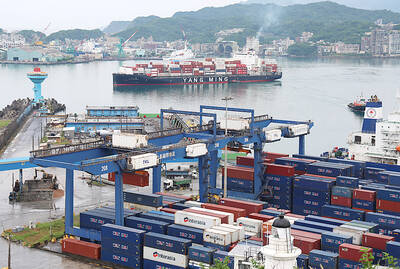A prolonged decline in contract DRAM chip prices is expected to end next quarter, ahead of expectations, as price increases on the spot market have shored up electronic component buyers’ willingness to rebuild inventory following an inventory correction that lasted five quarters, TrendForce Corp (集邦科技) said yesterday.
The market researcher’s latest forecast contrasted with its prediction last month, when it said that overall DRAM chip prices would drop by a single-digit percentage in the first quarter of next year and that prices would likely fall about 50 percent annually this year.
The positive revision came as spot DRAM chip prices rose 0.4 to 2.08 percent yesterday, according to the DRAMexchange Web site.
With a stockpile of downgraded 1x-nanometer DRAM chips being quickly digested, spot prices started to rise, TrendForce said in a report.
The Taipei-based researcher said DRAM used in servers and graphic cards would be the first beneficiaries, as they have seen robust demand lately.
Contract prices for DRAM used in servers are expected to increase 5 percent next quarter from this quarter, it said.
“The trends indicate that original equipment manufacturers for servers are becoming more proactive in building up their DRAM inventories,” TrendForce said.
That has reflected on significant growth in shipments of mainstream DRAM modules used in servers, buoying the prices of memory chips, it said.
TrendForce attributed the price increases to an unstable supply of DRAM chips built using the 1x-nanometer process technology and robust short-term demand.
Contract chip prices for DRAM used in graphic cards are expected to climb slightly next quarter, as microprocessor makers have reduced their inventories to a healthy level and started buying new GDDR6 chips, the researcher said.
Increasing prices of DRAM used in servers and graphic cards would help bring overall DRAM prices to a flat level next quarter, compared with this quarter, it said.
An extensive price rebound is expected to start in the beginning of the second quarter of next year, it added.
DRAM supply still exceeds demand this quarter and the situation would last for two more quarters, the researcher said.

Taiwan’s exports soared 56 percent year-on-year to an all-time high of US$64.05 billion last month, propelled by surging global demand for artificial intelligence (AI), high-performance computing and cloud service infrastructure, the Ministry of Finance said yesterday. Department of Statistics Director-General Beatrice Tsai (蔡美娜) called the figure an unexpected upside surprise, citing a wave of technology orders from overseas customers alongside the usual year-end shopping season for technology products. Growth is likely to remain strong this month, she said, projecting a 40 percent to 45 percent expansion on an annual basis. The outperformance could prompt the Directorate-General of Budget, Accounting and

The demise of the coal industry left the US’ Appalachian region in tatters, with lost jobs, spoiled water and countless kilometers of abandoned underground mines. Now entrepreneurs are eyeing the rural region with ambitious visions to rebuild its economy by converting old mines into solar power systems and data centers that could help fuel the increasing power demands of the artificial intelligence (AI) boom. One such project is underway by a non-profit team calling itself Energy DELTA (Discovery, Education, Learning and Technology Accelerator) Lab, which is looking to develop energy sources on about 26,305 hectares of old coal land in

Netflix on Friday faced fierce criticism over its blockbuster deal to acquire Warner Bros Discovery. The streaming giant is already viewed as a pariah in some Hollywood circles, largely due to its reluctance to release content in theaters and its disruption of traditional industry practices. As Netflix emerged as the likely winning bidder for Warner Bros — the studio behind Casablanca, the Harry Potter movies and Friends — Hollywood’s elite launched an aggressive campaign against the acquisition. Titanic director James Cameron called the buyout a “disaster,” while a group of prominent producers are lobbying US Congress to oppose the deal,

Two Chinese chipmakers are attracting strong retail investor demand, buoyed by industry peer Moore Threads Technology Co’s (摩爾線程) stellar debut. The retail portion of MetaX Integrated Circuits (Shanghai) Co’s (上海沐曦) upcoming initial public offering (IPO) was 2,986 times oversubscribed on Friday, according to a filing. Meanwhile, Beijing Onmicro Electronics Co (北京昂瑞微), which makes radio frequency chips, was 2,899 times oversubscribed on Friday, its filing showed. The bids coincided with Moore Threads’ trading debut, which surged 425 percent on Friday after raising 8 billion yuan (US$1.13 billion) on bets that the company could emerge as a viable local competitor to Nvidia